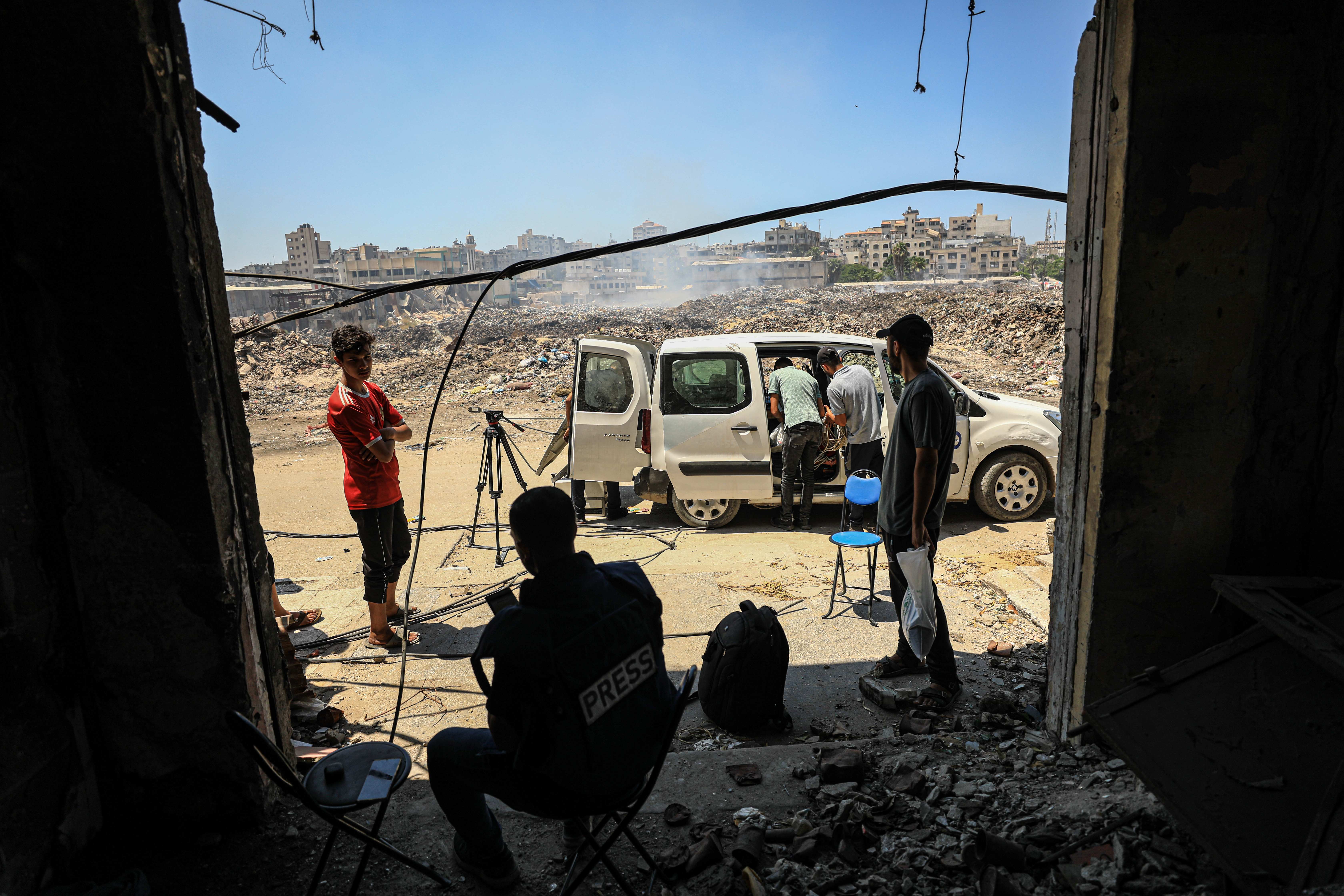مع دخول الحرب على غزة عامها الثاني. وبعد لحظات فقط، باغتتهم طائرات مسيرة من طراز "كواد كابتر"، وأطلقت نيرانها بكثافة نحوهم، لتستقر إحدى الرصاصات في عنق فادي، البالغ من العمر 24 عاما، ليهوي على الأرض بلا حراك. صرخ الصحفي إسلام بدر، مراسل قناة العربي، الذي كان قريبا منه، وكذلك الصحفي أنس الشريف، مراسل قناة الجزيرة الموجود على الجهة المقابلة، محاولين إسعافه لكن من دون استجابة. عند ذلك قرر إسلام الاندفاع نحوه رغم وابل الرصاص، وحمله مسرعا إلى المستشفى.
أصيب فادي بشلل كامل، ولم يعد جسده يقوى على الحركة، لينتهي بذلك مشواره في الميدان الذي لم يفارقه طوال عام من الحرب. في اليوم نفسه، كان مراسل قناة الأقصى تامر لبد ينهي تقريره الميداني غرب مخيم جباليا شمالي قطاع غزة برفقة المصور الشاب محمد الطناني قبل أن يباغتهما صاروخ طائرة مسيرة بترت قدمي محمد الذي فارق الحياة فورا، بينما استقرت عدة شظايا في جسد تامر وخضع لعملية جراحية لانتشالها.
حادثتان متزامنتان تلخصان حال صحفيي شمال قطاع غزة الذين قرروا كسر عام من العزلة فرضته قوات الاحتلال عليهم بالترهيب وقوة النار، رافضين إغلاق عدسات الكاميرات وإخلاء شمال قطاع غزة إلى جنوبها.
تعود معركة جيش الاحتلال مع صحفيي شمال قطاع غزة إلى بداية الحرب البرية نهاية أكتوبر من العام 2023، عندما طالب أكثر من مليون شخص من سكان محافظتي غزة والشمال بمن فيهم الصحفيون بترك منازلهم ومقار عملهم والتوجه جنوبا، في محاولة منه لإفراغ ما يقرب من نصف مساحة القطاع وإبادته في غياب الصورة والبث المباشر.
كانت تلك لحظات حاسمة لمجموعة من الصحفيين، معظمهم من الشباب الذين بدؤوا مسيرتهم الصحفية حديثا، واختاروا التمسك برسالتهم، رافعين شعار "نرفض الصمت، ويجب أن تستمر التغطية."
اتفق الصحفيون على كسر العزلة التي قررت قوات الاحتلال فرضها عليهم، والحفاظ على التواصل مع المصادر الميدانية؛ فقد فتحوا قناة اتصال مباشرة مع طواقم الإسعاف والدفاع المدني كي يُزوَّدوا بتطورات الأحداث لتوثيق فظاعة الجرائم بحق الأطفال والنساء والمسنين
وسط النيران التي أشعلت شمال غزة، كانت رسائل هؤلاء الصحفيين الشبان، ومعظمهم لم يتجاوز الخامسة والثلاثين من العمر، تصل إلى شاشات التلفزيونات العربية والدولية وتملأ قاعات تحرير وكالات الأنباء بصور الضحايا الذين حوّلهم الاحتلال إلى أشلاء.
وسط استمرار القصف العنيف والخوف من الآليات التي تتوغل نحو المناطق المكتظة بالسكان، تسلح الصحفيون بأدوات بسيطة تُمكنهم من إيصال رسالتهم. حمل كل منهم حقيبة صغيرة لا تفارق ظهره، تحتوي على هاتف محمول وشاحن إضافي (باور بنك) للتغلب على انقطاع الكهرباء عن غزة منذ بدء حرب الإبادة الجماعية. كذلك اعتمدوا على شرائح إلكترونية (eSIM) أو تلك التابعة لشركات اتصالات إسرائيلية للتغلب على انقطاع الإنترنت المتعمد في شمال غزة، لإرسال تغطياتهم الميدانية.
أسس كل منهم ما يشبه وحدة بث متنقلة، قادرة على توثيق جرائم الاحتلال، وركضوا بها هربا من نيران لم تشهد غزة كثافة أو قوة تدميرية مماثلة لها من قبل. ورغم قلة عدد الصحفيين الذين رابطوا في شمال غزة، فقد استطاعوا تغطية الأحداث على مدار الساعة من دون نوم، ولم يغادروا الميدان، متنقلين من زقاق إلى آخر لنقل الصورة الحقيقية.
داخل المستشفى الأهلي العربي "المعمداني"، اجتمع الصحفيون الذين أُجبروا للتو على مغادرة مخيم جباليا بعد فرض قوات الاحتلال حصارا شاملا عليه، حيث اعتُقل بعضهم لساعات قبل السماح لهم بالمغادرة. دار الحديث بينهم عن كيفية نقل الصورة وتوثيق الجرائم الإسرائيلية بحق المدنيين المحاصرين، وتحدي التعتيم الإعلامي الذي سعى الجيش لفرضه لإخفاء المجازر المرتكبة بحق المواطنين.
اتفق الصحفيون على كسر العزلة التي قررت قوات الاحتلال فرضها عليهم، والحفاظ على التواصل مع المصادر الميدانية؛ فقد فتحوا قناة اتصال مباشرة مع طواقم الإسعاف والدفاع المدني كي يُزوَّدوا بتطورات الأحداث لتوثيق فظاعة الجرائم بحق الأطفال والنساء والمسنين.
نفتقر إلى بيئة مجهزة لعمل الإعلاميين، بينما يلاحف الاحتلال منصات الصحفيين عبر مواقع التواصل الاجتماعي ويعمل على حظرها، عدا عن تواصله مع القنوات الأوروبية وبعض القنوات العربية، والضغط عليها لعدم التعامل مع الصحفيين داخل القطاع، وقد نجح مرارا في ذلك
ظهرت تحديات عديدة أمام الصحفيين المقيمين في البقعة الشمالية لقطاع غزة بعد أن حال إغلاق المعابر والطرقات دون توفير معداتهم التي عانوا من شحها واختفائها من الأسواق؛ فلا توجد دروع واقية ولا خوذ تحمي رؤوسهم ولا أجهزة تسجيل صوتية أو معدات تصوير احترافية وملحقاتها.
حاولت "مجلة الصحافة" توثيق أهم التحديات التي يواجهها صحفيو غزة عبر استطلاع آرائهم:
المصور الصحفي المصاب فادي الوحيدي:
"أناشد كل المؤسسات التي تعنى بحرية الصحافة العمل على تسهيل سفري والضغط على الاحتلال لتلقي العلاج خارج قطاع غزة بعدما شلت أطرافي نتيجة طلقات طائرات مسيرة أصابت النخاع الشوكي. إذا لم يتحرك أحد لإنقاذي فإن حياتي معرضة للخطر، وسيفقد العالم صحفيا آخر، لم يقترف ذنبا إلا أنه بقي على رأس عمله في شمال غزة.
الصحفي محمد شاهين مراسل الجزيرة مباشر:
تتمثل التحديات في صعوبة التنقل والمواصلات وغياب حصانة الصحفي وعدم وجود مناطق محمية وآمنة بعد استهداف الأسواق ومراكز الإيواء والشوارع والمستشفيات التي يتركز بها عمل الصحفيين.
أتعبنا النزوح والتنقل من مكان إلى آخر من دون أن نتمكن من إجلاء المعدات جميعها، في الوقت الذي نواجه فيه صعوبة توفير التالف أو الفاقد منها.
عماد زقوت:
نواجه عقبات وتحديات عديدة في أثناء التغطية، أبرزها الاستهداف المباشر للصحفيين، والحصار العسكري الإسرائيلي لشمال غزة، ونزوح عائلات الصحفيين وتشتتهم.
نعاني من تعطل شبكات الإنترنت والاتصالات؛ الأمر الذي يعوق التواصل. كذلك برزت ظاهرة غريبة في هذه الحرب؛ إذ بات الأهالي يخشون التعامل مع الصحفيين جراء تعرض بعضهم للتهديد الإسرائيلي واستشهاد عدد كبير منهم.
برزت ظاهرة غريبة في هذه الحرب؛ إذ بات الأهالي يخشون التعامل مع الصحفيين جراء تعرض بعضهم للتهديد الإسرائيلي واستشهاد عدد كبير منهم.
الصحفي محمد أحمد مراسل قناة TRT عربي:
نفتقر إلى بيئة مجهزة لعمل الإعلاميين، بينما يلاحق الاحتلال منصات الصحفيين عبر مواقع التواصل الاجتماعي ويعمل على حظرها، عدا عن تواصله مع القنوات الأوروبية وبعض القنوات العربية للأسف والضغط عليها لعدم التعامل مع الصحفيين داخل القطاع، وقد نجح مرارا في ذلك. لا تتوفر وسائل اتصال خارج سيطرة الاحتلال وتأثيره، والنزوح المتكرر يزيد من معاناة الصحفي الذي يعيش في حالة عدم استقرار.







































